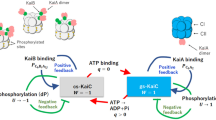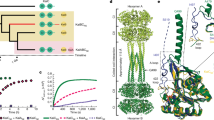Abstract
The cyanobacterial circadian oscillator can be reconstituted in vitro by mixing three purified clock proteins, KaiA, KaiB and KaiC, with ATP. The KaiC phosphorylation rhythm persists for at least 10 days without damping. By mixing oscillatory samples that have different phases and analyzing the dynamics of their phase relationships, we found that the robustness of the KaiC phosphorylation rhythm arises from the rapid synchronization of the phosphorylation state and reaction direction (phosphorylation or dephosphorylation) of KaiC proteins. We further demonstrate that synchronization is tightly linked with KaiC dephosphorylation and is mediated by monomer exchange between KaiC hexamers during the early dephosphorylation phase. This autonomous synchronization mechanism is probably the basis for the resilience of the cyanobacterial circadian system against quantitative fluctuations in clock components during cellular events such as cell growth and division.
This is a preview of subscription content, access via your institution
Access options
Subscribe to this journal
Receive 12 print issues and online access
$189.00 per year
only $15.75 per issue
Buy this article
- Purchase on Springer Link
- Instant access to full article PDF
Prices may be subject to local taxes which are calculated during checkout





Similar content being viewed by others
References
Pittendrigh, C.S. Temporal organization: reflections of a Darwinian clock-watcher. Annu. Rev. Physiol. 55, 16–54 (1993).
Nakajima, M. et al. Reconstitution of circadian oscillation of cyanobacterial KaiC phosphorylation in vitro. Science 308, 414–415 (2005).
Kondo, T. et al. Circadian rhythms in rapidly dividing cyanobacteria. Science 275, 224–227 (1997).
Mihalcescu, I., Hsing, W. & Leibler, S. Resilient circadian oscillator revealed in individual cyanobacteria. Nature 430, 81–85 (2004).
Amdaoud, M., Vallade, M., Weiss-Schaber, C. & Mihalcescu, I. Cyanobacterial clock, a stable phase oscillator with negligible intercellular coupling. Proc. Natl. Acad. Sci. USA 104, 7051–7056 (2007).
Kondo, T. et al. Circadian rhythms in prokaryotes: luciferase as a reporter of circadian gene expression in cyanobacteria. Proc. Natl. Acad. Sci. USA 90, 5672–5676 (1993).
Kageyama, H. et al. Cyanobacterial circadian pacemaker: Kai protein complex dynamics in the KaiC phosphorylation cycle in vitro. Mol. Cell 23, 161–171 (2006).
Nishiwaki, T. et al. A sequential program of dual phosphorylation of KaiC as a basis for circadian oscillation in cyanobacteria. EMBO J. 26, 4029–4037 (2007).
van Zon, J.S., Lubensky, D.K., Altena, P.R.H. & ten Wolde, P.R. An allosteric model of circadian KaiC phosphorylation. Proc. Natl. Acad. Sci. USA 104, 7420–7425 (2007).
Yoda, M., Eguchi, K., Terada, T. & Sasai, M. Monomer-shuffling and allosteric transition in KaiC circadian oscillation. PLoS ONE 2, e408 (2007).
Mori, T. et al. Elucidating the ticking of an in vitro circadian clockwork. PLoS Biol. 5, e93 (2007).
Takigawa-Imamura, H. & Mochizuki, A. Predicting regulation of the phosphorylation cycle of KaiC clock protein using mathematical analysis. J. Biol. Rhythms 21, 405–416 (2006).
Tomita, J., Nakajima, M., Kondo, T. & Iwasaki, H. No transcription-translation feedback in circadian rhythm of KaiC phosphorylation. Science 307, 251–254 (2005).
Imai, K., Nishiwaki, T., Kondo, T. & Iwasaki, H. Circadian rhythms in the synthesis and degradation of a master clock protein KaiC in cyanobacteria. J. Biol. Chem. 279, 36534–36539 (2004).
Elowitz, M.B. & Leibler, S. A synthetic oscillatory network of transcriptional regulators. Nature 403, 335–338 (2000).
Nagoshi, E. et al. Circadian gene expression in individual fibroblasts: cell-autonomous and self-sustained oscillators pass time to daughter cells. Cell 119, 693–705 (2004).
Barkai, N. & Leibler, S. Circadian clocks limited by noise. Nature 403, 267–268 (2000).
Gonze, D., Halloy, J. & Goldbeter, A. Robustness of circadian rhythms with respect to molecular noise. Proc. Natl. Acad. Sci. USA 99, 673–678 (2002).
Raser, J.M. & O'Shea, E.K. Noise in gene expression: origins, consequences, and control. Science 309, 2010–2013 (2005).
Elowitz, M.B., Levine, A.J., Siggia, E.D. & Swain, P.S. Stochastic gene expression in a single cell. Science 297, 1183–1186 (2002).
Rosenfeld, N., Young, J.W., Alon, U., Swain, P.S. & Elowitz, M.B. Gene regulation at the single-cell level. Science 307, 1962–1965 (2005).
Liu, C., Weaver, D.R., Strogatz, S.H. & Reppert, S.M. Cellular construction of a circadian clock: period determination in the suprachiasmatic nuclei. Cell 91, 855–860 (1997).
Kitayama, Y., Iwasaki, H., Nishiwaki, T. & Kondo, T. KaiB functions as an attenuator of KaiC phosphorylation in the cyanobacterial circadian clock system. EMBO J. 22, 2127–2134 (2003).
van den Pol, A.N. in Suprachiasmatic Nucleus: The Mind's Clock (eds. Klein, D.C., Moore, R.Y. & Reppert, S.M.) 17–50 (Oxford University Press, New York, 1991).
Acknowledgements
We thank H. Kondo and M. Tamura for excellent technical assistance and M. Yamamura (Tokyo Institute of Technology) for comments. This research was supported in part by Grants-in-Aid from the Ministry of Education, Culture, Sports, Science and Technology of Japan (15GS0308 to T.K. and T.O.) and the Japan Society for the Promotion of Science (17370088 to T.O.). H.I. and M.M. were each supported by a Research Fellowship for Young Scientists from the Japan Society for the Promotion of Science (18005539 to H.I. and 17007534 to M.M.).
Author information
Authors and Affiliations
Contributions
H.I. and T.O. designed research; H.I., H.K., M.M. and M.N. performed research; H.I., H.K., T.O. and T.K. analyzed data; and H.I., T.O. and T.K. wrote the paper.
Corresponding authors
Supplementary information
Supplementary Text and Figures
Supplementary Figs. 1–3 (PDF 1316 kb)
Rights and permissions
About this article
Cite this article
Ito, H., Kageyama, H., Mutsuda, M. et al. Autonomous synchronization of the circadian KaiC phosphorylation rhythm. Nat Struct Mol Biol 14, 1084–1088 (2007). https://doi.org/10.1038/nsmb1312
Received:
Accepted:
Published:
Issue Date:
DOI: https://doi.org/10.1038/nsmb1312
This article is cited by
-
Coupling of distant ATPase domains in the circadian clock protein KaiC
Nature Structural & Molecular Biology (2022)
-
Mechanism of autonomous synchronization of the circadian KaiABC rhythm
Scientific Reports (2021)
-
The energy cost and optimal design for synchronization of coupled molecular oscillators
Nature Physics (2020)
-
Synchronization by uncorrelated noise: interacting rhythms in interconnected oscillator networks
Scientific Reports (2018)



